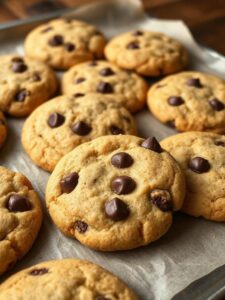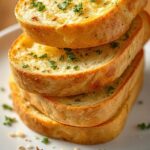There’s something incredibly satisfying about pulling a tray of fresh, golden cookies out of the oven. The aroma fills the kitchen, the warmth radiates from the pan, and the anticipation of that first bite makes baking them almost as rewarding as eating them. Over the years, I’ve baked countless batches, and I can confidently say that a simple homemade cookies recipe is one of the most versatile and reliable treasures you can have in your kitchen repertoire.
When I talk about “simple,” I don’t mean boring or plain. I’m talking about a recipe that’s easy to follow, doesn’t require unusual ingredients, and still delivers cookies with the perfect balance of texture and flavor. Whether you’re baking for your family, entertaining guests, or just treating yourself, these cookies will hit the sweet spot every single time.
The beauty of a simple homemade cookies recipe is that you can tailor it to your taste. You can keep it classic with a buttery vanilla base or dress it up with chocolate chips, nuts, or dried fruits. Either way, the foundation remains the same—a reliable, straightforward method that even beginner bakers can master.
If you’ve ever felt intimidated by baking, this recipe is your starting point. And if you’re already experienced, it’s the perfect base to let your creativity shine. By the end of this article, you’ll know not just how to make these cookies, but also how to tweak them for different occasions, avoid common mistakes, and store them for maximum freshness.
Why Make Cookies at Home?
Baking cookies at home offers a level of satisfaction you just can’t get from a store-bought package. For me, it’s about more than just the end result—it’s the process. The act of mixing the ingredients, shaping the dough, and waiting for the magic to happen in the oven is a comforting ritual.
One of the biggest advantages is control. When I make cookies from scratch, I decide exactly what goes into them. That means I can choose high-quality butter, real vanilla extract, and fresh eggs. I can also control the amount of sugar, which is great if I want a less-sweet batch for kids or a richer one for a special treat.
Homemade cookies are also fresher. There’s no comparison between a cookie that’s been sitting on a supermarket shelf for weeks and one that’s just cooled on your kitchen counter. The texture, the aroma, the warmth—they’re incomparable.
There’s also the flexibility factor. Maybe you’re in the mood for chocolate chip today, oatmeal raisin tomorrow, or peanut butter next week. Once you’ve mastered a simple homemade cookies recipe, you can adapt it to almost any flavor combination you like.
And let’s not forget the emotional connection. Some of my most cherished childhood memories involve baking cookies with my family. That’s the kind of tradition you can create in your own home, passing down the recipe and the love that comes with it.
Key Ingredients for the Perfect Homemade Cookies
The heart of any recipe lies in its ingredients, and cookies are no exception. With just a handful of staple items, you can create magic. But it’s not just about having the right ingredients—it’s about choosing the best versions of them.
Flour
I usually go for all-purpose flour because it provides the perfect structure without making the cookies too dense. Sifting the flour can help you avoid lumps and ensure even mixing, which is key for consistent texture.
Butter
This is where much of the flavor comes from. I prefer unsalted butter so I can control the saltiness myself. Softened butter mixes more easily with sugar, creating that light, fluffy base for the dough. If you want a deeper, nuttier flavor, try browning your butter before adding it—just let it cool slightly first.
Sugar
A mix of white granulated sugar and brown sugar gives cookies the ideal combination of crisp edges and chewy centers. White sugar helps with spreading and crisping, while brown sugar adds moisture and a subtle caramel-like sweetness.
Eggs
Eggs act as binders and add richness. Room-temperature eggs incorporate better into the batter, helping to create a smooth dough.
Leavening Agents
Baking soda or baking powder—sometimes both—are what give cookies a bit of lift and softness. I always double-check freshness because old leavening agents can lead to flat, disappointing cookies.
Flavorings
Pure vanilla extract is my go-to, but you can experiment with almond extract or spices like cinnamon and nutmeg. These small touches can make your cookies stand out.
Mix-ins
Chocolate chips, chopped nuts, dried fruit—this is where you can let your personality shine. For a classic, I’ll go with semi-sweet chocolate chips, but white chocolate chunks or toasted pecans are also wonderful.
Essential Baking Tools You’ll Need
While cookies don’t require a professional bakery setup, having the right tools can make the process smoother and the results more consistent.
- A sturdy mixing bowl is the starting point. I like to use a large, heavy-duty bowl so I have plenty of space to mix without spilling flour everywhere.
- An electric mixer—either hand-held or stand—can save you time and effort, especially when creaming butter and sugar. However, if you prefer a more hands-on approach, a good wooden spoon works just fine.
- A set of measuring cups and spoons is essential for accuracy. Baking is a science, and even small changes in ingredient amounts can alter the outcome.
- A baking sheet with a non-stick surface or lined with parchment paper ensures cookies bake evenly and don’t stick. I keep multiple sheets on hand so I can rotate batches quickly.
- A cookie scoop might sound optional, but it’s one of my favorite tools for achieving uniform cookies. Not only does it make them look professional, but it also helps them bake evenly.
- Finally, a cooling rack is crucial. Leaving cookies on a hot pan can cause them to overcook and lose their perfect texture. Transferring them to a rack allows air to circulate, preserving that ideal balance of crisp and chewy.
Tips for Choosing Quality Ingredients
Over the years, I’ve learned that the quality of your ingredients makes a bigger difference in cookies than you might expect. Even the simplest recipe can taste extraordinary if you choose wisely.
When it comes to butter, I always recommend real, high-fat butter over margarine. The higher fat content gives cookies a richer flavor and better texture. If you can, look for European-style butter, which has an even higher butterfat percentage.
For flour, freshness matters more than most people realize. Flour can lose its strength and develop off-flavors if stored too long. I like to keep mine in an airtight container and use it within six months.
When choosing sugar, pay attention to texture. Soft, moist brown sugar blends better and gives you chewier cookies. If your brown sugar has hardened, it’s worth replacing rather than trying to re-soften it.
Eggs are best when fresh, but I also prefer free-range or organic eggs for their richer yolk color and slightly deeper flavor. Bringing them to room temperature before baking ensures they mix evenly.
Lastly, vanilla extract is one place I never cut corners. Pure vanilla extract—made from real vanilla beans—adds a depth of flavor that imitation versions just can’t match. If you really want to impress, try using vanilla bean paste for visible flecks and a more intense aroma.
Step-by-Step Simple Homemade Cookies Recipe
Here’s my tried-and-true method for creating cookies that come out perfect every time. It’s straightforward, but I’ll also share little tips I’ve picked up along the way that make all the difference.
Ingredients:
-
2 ¼ cups all-purpose flour
-
1 cup unsalted butter, softened
-
¾ cup white sugar
-
¾ cup packed brown sugar
-
2 large eggs, room temperature
-
1 teaspoon pure vanilla extract
-
1 teaspoon baking soda
-
½ teaspoon salt
-
2 cups chocolate chips (or mix-ins of choice)
Instructions:
First, preheat your oven to 350°F (175°C). This ensures it’s at the right temperature before your dough is ready—cookies bake best when the heat is stable.
In a large bowl, cream together the softened butter, white sugar, and brown sugar until light and fluffy. This step isn’t just about mixing; you’re incorporating air into the butter, which helps give the cookies a soft texture. I usually do this for about 2–3 minutes with an electric mixer on medium speed.
Beat in the eggs, one at a time, making sure each is fully incorporated before adding the next. Then stir in the vanilla extract. At this point, your batter should be smooth and glossy.
In a separate bowl, whisk together the flour, baking soda, and salt. Gradually add this dry mixture to the wet ingredients, mixing just until combined. Over-mixing at this stage can lead to tough cookies, so I stop as soon as there are no streaks of flour left.
Fold in the chocolate chips (or your chosen mix-ins) using a spatula. This method is gentler than using the mixer and helps keep the dough tender.
Use a cookie scoop or spoon to drop rounded tablespoons of dough onto a baking sheet lined with parchment paper, spacing them about 2 inches apart.
Bake for 9–11 minutes, or until the edges are golden but the centers still look slightly soft. Remember, cookies continue to cook a little on the sheet after they’re removed from the oven.
Let them cool on the baking sheet for 2–3 minutes before transferring to a wire rack to cool completely. This prevents them from breaking apart while still warm.
Baking Tips for Beginners
If you’re new to baking, the process can feel intimidating, but I promise it doesn’t have to be. These are the tips I wish someone had told me when I first started making cookies.
First, measure your ingredients accurately. Baking isn’t like cooking—you can’t just “eyeball” it and expect perfect results. I always spoon flour into the measuring cup and level it off with a knife rather than scooping directly from the bag, which can pack the flour and lead to dense cookies.
Second, keep an eye on baking time. Every oven runs a little differently, so your cookies might be done a minute earlier or later than expected. I like to check them two minutes before the recommended time, just in case.
Third, don’t skip cooling time. Moving cookies too early can cause them to fall apart, but letting them sit too long on a hot baking sheet can make them overbake. That’s why I recommend transferring them to a cooling rack as soon as they’re set enough to handle.
Lastly, if you want cookies that are thick and chewy, chill your dough for at least 30 minutes before baking. This slows the spread of the cookies in the oven and gives you a better texture.
Common Mistakes to Avoid When Making Cookies
Even with a simple homemade cookies recipe, there are a few traps that can lead to disappointing results. Over the years, I’ve made every mistake possible, and I’ve learned exactly how to avoid them.
One of the biggest is over-mixing the dough. Once you add the dry ingredients, mix only until the flour is incorporated. Too much mixing develops the gluten, which can make your cookies tough instead of tender.
Another common mistake is baking on a hot sheet pan. If you’re baking multiple batches, let your baking sheet cool completely between batches or use a fresh one. Placing dough on a hot surface causes it to start melting before it even reaches the oven, leading to thin, over-spread cookies.
Not measuring accurately can also ruin a batch. Too much flour makes cookies dry and crumbly; too little flour makes them spread too much. The same goes for sugar—changing the ratio will affect both texture and sweetness.
Finally, over-baking is a surefire way to lose that soft, chewy texture. Cookies should come out of the oven when the edges are golden and the centers still look slightly soft. They’ll firm up as they cool.
Variations You Can Try
Once you’ve mastered the base recipe, the possibilities are endless. This is where I like to get creative and experiment with flavors and textures.
For a classic twist, swap half the chocolate chips for white chocolate chunks and add a handful of macadamia nuts. The combination is rich, buttery, and a little tropical.
If you love spice, try cinnamon and nutmeg in the dough, along with raisins or chopped dates. This gives the cookies a warm, cozy flavor perfect for autumn.
For something decadent, drizzle baked cookies with melted dark chocolate or sandwich two cookies together with a layer of buttercream.
You can even make healthier variations by replacing some of the all-purpose flour with oat flour, using dark chocolate instead of milk chocolate, or adding chia seeds for extra texture.
How to Store Homemade Cookies
There’s nothing worse than baking a perfect batch of cookies only to find them stale the next day. Luckily, with the right storage method, your cookies can stay fresh and delicious for days—or even weeks.
For short-term storage, I keep cookies in an airtight container at room temperature. Layer them with parchment paper to prevent sticking, especially if they’re soft and chewy. They usually stay fresh for about 4–5 days this way.
If you want to keep them longer, freezing is your best option. Place cooled cookies in a freezer-safe bag or container, separating layers with parchment paper. They’ll keep well for up to three months. To enjoy, just let them thaw at room temperature or warm them for a few seconds in the microwave.
Another trick I use is to store a slice of bread in the container with the cookies. The bread releases moisture, which helps keep the cookies soft without making them soggy.
Serving Suggestions
While I’m perfectly happy enjoying cookies on their own, pairing them with the right drink or dessert can elevate the experience.
For a classic combination, you can’t go wrong with a cold glass of milk. If you want something richer, try serving cookies warm with a scoop of vanilla ice cream for an easy dessert.
Cookies also pair beautifully with hot drinks like coffee, hot chocolate, or chai tea. I’ve even used crumbled cookies as a topping for yogurt or pudding for a quick and indulgent snack.
If you’re hosting a gathering, arrange different cookie varieties on a platter for guests to sample. It makes for a visually appealing centerpiece and encourages people to try different flavors.
FAQs About Homemade Cookies
Can I freeze cookie dough?
Absolutely. Shape the dough into balls, place them on a baking sheet to freeze, then transfer to a freezer bag. You can bake them straight from frozen—just add a minute or two to the baking time.
Why did my cookies turn out flat?
Flat cookies are often caused by butter that’s too soft or melted, too little flour, or baking on a hot pan. Chilling the dough can help.
Can I make these cookies gluten-free?
Yes. Substitute a good-quality gluten-free all-purpose flour blend for the regular flour. You may need to adjust the texture slightly with extra moisture, depending on the brand.
Nutritional Information (Per Cookie – Approximate)
| Nutrient | Amount |
|---|---|
| Calories | 180 |
| Total Fat | 9g |
| Saturated Fat | 5g |
| Carbohydrates | 24g |
| Sugar | 15g |
| Protein | 2g |
These values can change depending on the mix-ins you choose, so consider them a guideline rather than an exact figure.
Final Thoughts
Baking cookies at home isn’t just about making something sweet—it’s about creating moments, memories, and comfort. With a simple homemade cookies recipe like this, you have the freedom to customize, experiment, and make each batch uniquely yours.
Every time I bake these cookies, I’m reminded of why I started baking in the first place. It’s the joy of seeing people’s faces light up when they take that first bite, the aroma that makes a house feel like a home, and the satisfaction of knowing exactly what went into the treat you’re sharing.
So whether you stick to the classic or try your own variations, I promise this recipe will be one you’ll reach for again and again.




